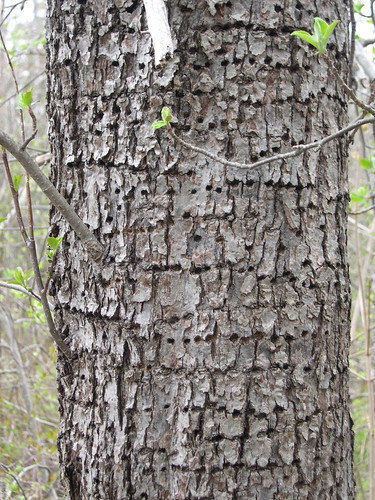As we get all excited about the sap running, so do other critters. Perhaps first among them is the yellow-bellied sapsucker, who winters in the south. Around now, the sapsuckers start migrating north, following this rich food source as each successive latitude warms up enough to start the flow.
Sapsuckers make a series of round holes in a tree's bark, usually lined up in efficient little rows. They then lap up the sap that comes out -- sometimes returning to holes over and over as the sap continues to ooze.
In addition to their their distinctive holes, sapsuckers are a distinctive-looking bird. Like other woodpeckers, they've got mottled black and whitish feathers on their back and wings. Both males and females have a red spot on the top of their head; males also have a red throat. The belly has just a hint of yellow that you won't be able to detect without exactly the right light -- the picture above may be the yellowest I've ever seen.
The yellow-bellied sapsucker is considered a "keystone" species by some ecologists because many other birds rely on them. It's a hard time of year to find food, and other species -- including kinglets, warblers, phoebes, and even hummingbirds -- will follow behind the sapsuckers to lap up sap or insects.
But sapsuckers don't subsist entirely on sugar -- good thing, because the sap doesn't flow all year. The sapsucker may also make rectangular holes that allow them to get to the tree's phloem, which they eat. And, like other woodpeckers, they eat a lot of insects. Even when the sap is running, many insects either get uncovered by drilling into the tree, or are themselves attracted to the sap.
But no other woodpecker in our area makes such systematic holes in the trees. If you see a tidy little row, it was probably a sapsucker.
In the wild: You can find sapsuckers throughout the open woods of our region. If you see some holes actively oozing sap, hang out quietly for a little while and see who comes by.
In your yard: Don't worry, sapsuckers generally do not cause serious damage to trees -- the wounds they make are pretty shallow. Sapsuckers come to the large oak tree in our backyard all the time, and it's going strong.
We read of one photographer who attracted sapsuckers to his yard by drilling holes in an upright log and filling them with corn syrup. Cheating? You decide. It must have been quite a sugar rush for the birds!
Have you seen sapsuckers lately? Let us know.
Like the photos in this post? Mouse over for credits; a click takes you to the photographer on Flickr.
Getting outside, inside the beltway: tips on getting outdoors in the Washington, DC area.
Most Popular Posts
-
Photo credit: ilkerender Last year we listed places to swim near DC and places to rent a canoe near DC . Today we return to complete the s...
-
Summer calls out for being on the water. We've found more than a dozen locations where you can rent a canoe or kayak in the Washington, ...
-
What a lovely break in the heat we're having. Here are some things to keep an eye out for in August. Links are to previous LOOK FOR post...
-
This spring has been cold and a little slow, like last year. Morels , in particular, are just starting to show up. Below are all the things ...
-
The Jack in the pulpits are starting to unfurl right now. I've always loved these flowers, showy in their design rather than their color...
-
I've been distracted from the Natural Capital but I haven't totally forgotten about you guys...Here are some of the other things we ...
-
This time last year, the wood frogs were out and had already laid their eggs. As of this morning, the pond where we always find them was com...
-
Our monthly roundup of things to look for this month: Photo credit: InspiredinDesMoines I originally wrote about bald eagles for t...
-
Two of the things we love best about living in the DC metro area are the public transportation system, and the parks. And so, one of our mai...
-
If I had to name my biggest frustration with the nature around DC, the lack of good swimming holes might top the list. Until 7th grade I liv...


